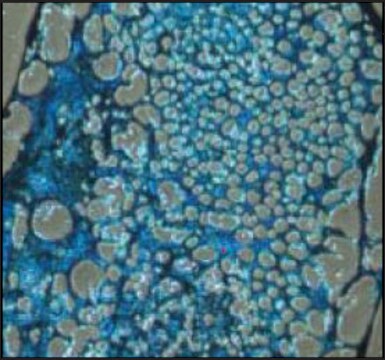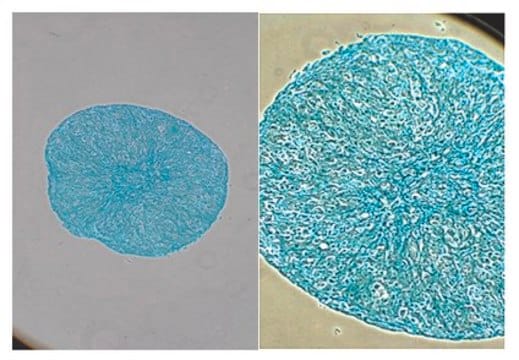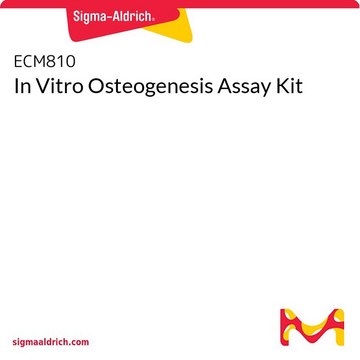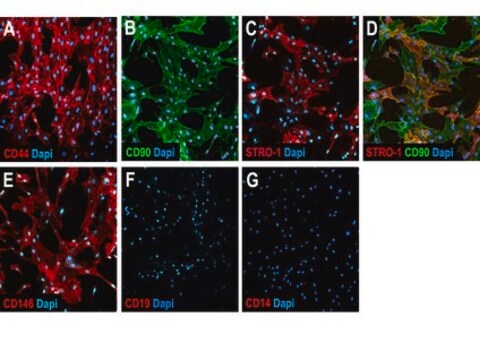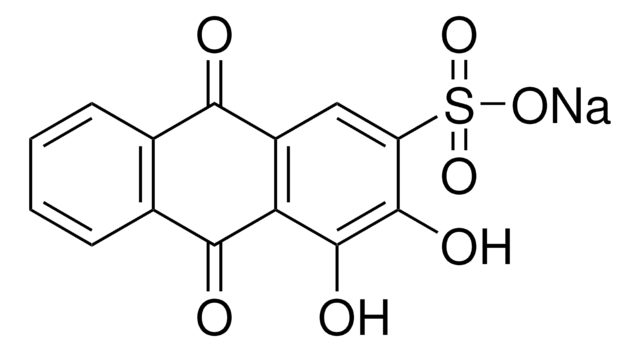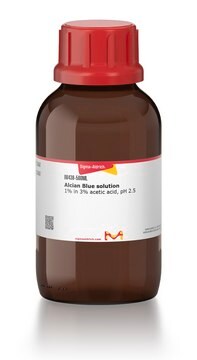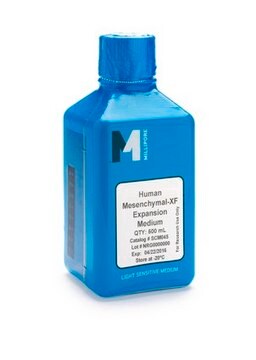SCR028
Mesenchymal Stem Cell Osteogenesis Kit
The Mesenchymal Stem Cell Osteogenesis Kit contains all the reagents necessary to readily differentiate mesenchymal stem cells to an osteogenic lineage as assessed by Alizarin Red staining.
로그인조직 및 계약 가격 보기
모든 사진(1)
About This Item
UNSPSC 코드:
12352207
eCl@ss:
32161000
NACRES:
NA.81
추천 제품
Quality Level
제조업체/상표
Chemicon®
기술
cell culture | stem cell: suitable
입력
sample type mesenchymal stem cell(s)
검출 방법
colorimetric
배송 상태
wet ice
일반 설명
Bone undergoes a continual remodeling process that requires the coordinated activity of two types of cells. Osteoclasts break down the bone matrix while osteoblasts deposits collagen, calcium, and phosphorous and other minerals to form new bone. The balance between the activity of osteoclasts and osteoblasts determine the mass and density of the bone. Many diseases of bone including osteoporosis, a common age-related phenomenon in post-menopausal women in which the bone mass has been greatly reduced, and osteogenesis imperfecta, also known as brittle-bone disease, are likely caused by the misregulation of osteoblasts and osteoclasts. Understanding the molecular mechanisms that underlie osteogenesis, the process by which new bone is formed is thus of critical importance.
Stem cell technology, particularly embryonic stem cells and/or mesenchymal stem cells, offer attractive sources of osteoblasts for tissue culture studies and for the biochemical dissection of the earliest steps involved in osteoblast cell determination. Mesenchymal stem cells are multipotent progenitor cells that have the capacity to differentiate into several mesenchymal cell lineages, including bone, cartilage and fat.
CHEMICON®′s Mesenchymal Stem Cell Osteogenesis Kit contains all the reagents necessary to readily differentiate mesenchymal stem cells to an osteogenic lineage as assessed by Alizarin Red staining. Reagents in the kit include two ECM coating molecules (collagen Type I and vitronectin) that have been shown to promote osteogenic differentiation of mesenchymal stem cells (Salasznyk, 2004) along with inducing reagents, dexamethasone, ascorbic acid 2-phosphate and b-glycerophosphate. Also included is Alizarin Red Solution, a staining solution that is used to detect the presence of calcium in bone.
Using CHEMICON′s Mesenchymal Stem Cell Osteogenesis Kit, we typically obtain >50% mature osteocytes from rat bone marrow derived mesenchymal stem cells. Efficiency of osteogenic differentiation may vary, depending upon the quality of the mesenchymal stem cells and if variations to the protocol are introduced.
For Research Use Only; not for use in diagnostic procedure.
Stem cell technology, particularly embryonic stem cells and/or mesenchymal stem cells, offer attractive sources of osteoblasts for tissue culture studies and for the biochemical dissection of the earliest steps involved in osteoblast cell determination. Mesenchymal stem cells are multipotent progenitor cells that have the capacity to differentiate into several mesenchymal cell lineages, including bone, cartilage and fat.
CHEMICON®′s Mesenchymal Stem Cell Osteogenesis Kit contains all the reagents necessary to readily differentiate mesenchymal stem cells to an osteogenic lineage as assessed by Alizarin Red staining. Reagents in the kit include two ECM coating molecules (collagen Type I and vitronectin) that have been shown to promote osteogenic differentiation of mesenchymal stem cells (Salasznyk, 2004) along with inducing reagents, dexamethasone, ascorbic acid 2-phosphate and b-glycerophosphate. Also included is Alizarin Red Solution, a staining solution that is used to detect the presence of calcium in bone.
Using CHEMICON′s Mesenchymal Stem Cell Osteogenesis Kit, we typically obtain >50% mature osteocytes from rat bone marrow derived mesenchymal stem cells. Efficiency of osteogenic differentiation may vary, depending upon the quality of the mesenchymal stem cells and if variations to the protocol are introduced.
For Research Use Only; not for use in diagnostic procedure.
애플리케이션
Research Category
Stem Cell Research
Stem Cell Research
The Mesenchymal Stem Cell Osteogenesis Kit contains all the reagents necessary to readily differentiate mesenchymal stem cells to an osteogenic lineage as assessed by Alizarin Red staining.
성분
Dexamethasone Solution: (Catalog No. 90357) One vial containing 100 μL of 10 mM dexamethasone in ethanol. Store at -20°C.
Ascorbic Acid 2-Phosphate Solution: (Catalog No. 2004011) One vial containing 500 μL of 100 mM ascorbic acid 2-phosphate in water. Store at -20°C.
Glycerol 2- Phosphate Solution: (Catalog No. 2004010) Three vials containing 1 mL of 1 M glycerol 2-phosphate in water. Store at -20°C.
Collagen, Type I: (Catalog No. 2004013) One vial containing 150 μg collagen Type I. Store at -20°C.
Vitronectin: (Catalog No. 2004012) One vial containing 150 μg vitronectin. Store at -20°C.
Alizarin Red Solution: (Catalog No. 2003999) One bottle containing 50 mL Alizarin Red Solution. Store at 2° to 8°C.
Ascorbic Acid 2-Phosphate Solution: (Catalog No. 2004011) One vial containing 500 μL of 100 mM ascorbic acid 2-phosphate in water. Store at -20°C.
Glycerol 2- Phosphate Solution: (Catalog No. 2004010) Three vials containing 1 mL of 1 M glycerol 2-phosphate in water. Store at -20°C.
Collagen, Type I: (Catalog No. 2004013) One vial containing 150 μg collagen Type I. Store at -20°C.
Vitronectin: (Catalog No. 2004012) One vial containing 150 μg vitronectin. Store at -20°C.
Alizarin Red Solution: (Catalog No. 2003999) One bottle containing 50 mL Alizarin Red Solution. Store at 2° to 8°C.
저장 및 안정성
Note: Kit components require two different storage temperatures.
Dexamethasone Solution, Ascorbic Acid 2-Phosphate Solution, Glycerol 2- Phosphate Solution, Collagen Type I, and Vitronectin should be stored at -20ºC. Alizarin Red Solution should be stored at 2° to 8°C.
Precautions
· Dexamethasone is an irritant and potentially toxic. DMSO is readily absorbed through the skin. Wear a lab coat and gloves when handling these solutions.
Please refer to the Material Safety Data Sheet at www.chemicon.com for further precautions.
Dexamethasone Solution, Ascorbic Acid 2-Phosphate Solution, Glycerol 2- Phosphate Solution, Collagen Type I, and Vitronectin should be stored at -20ºC. Alizarin Red Solution should be stored at 2° to 8°C.
Precautions
· Dexamethasone is an irritant and potentially toxic. DMSO is readily absorbed through the skin. Wear a lab coat and gloves when handling these solutions.
Please refer to the Material Safety Data Sheet at www.chemicon.com for further precautions.
법적 정보
CHEMICON is a registered trademark of Merck KGaA, Darmstadt, Germany
면책조항
Unless otherwise stated in our catalog or other company documentation accompanying the product(s), our products are intended for research use only and are not to be used for any other purpose, which includes but is not limited to, unauthorized commercial uses, in vitro diagnostic uses, ex vivo or in vivo therapeutic uses or any type of consumption or application to humans or animals.
신호어
Danger
유해 및 위험 성명서
Hazard Classifications
Eye Irrit. 2 - Flam. Liq. 2 - Repr. 1B - STOT SE 2
표적 기관
Eyes,Central nervous system
Storage Class Code
3 - Flammable liquids
Flash Point (°F)
48.2 °F
Flash Point (°C)
9 °C
시험 성적서(COA)
제품의 로트/배치 번호를 입력하여 시험 성적서(COA)을 검색하십시오. 로트 및 배치 번호는 제품 라벨에 있는 ‘로트’ 또는 ‘배치’라는 용어 뒤에서 찾을 수 있습니다.
Pooi Ling Mok et al.
International journal of molecular sciences, 18(2) (2017-02-18)
Mesenchymal stem cells are widely used in many pre-clinical and clinical settings. Despite advances in molecular technology; the migration and homing activities of these cells in in vivo systems are not well understood. Labelling mesenchymal stem cells with gold nanoparticles
Yin Yin Ooi et al.
World journal of stem cells, 5(1), 34-42 (2013-01-31)
To assess the capacity to isolate and expand mesenchymal stem cells (MSC) from bone marrow of CBA/Ca, ICR and Balb/c mice. Bone marrow of tibia and femur were flushed, cultured and maintained in supplemented Dulbecco's modified Eagle's medium. MSC immunophenotype
Zul'atfi Rahmat et al.
Stem cell research & therapy, 4(1), 12-12 (2013-01-30)
Mesenchymal stem cells (MSCs) are immunosuppressive, but we lack an understanding of how these adult stem cells are in turn affected by immune cells and the surrounding tissue environment. As MSCs have stromal functions and exhibit great plasticity, the influence
자사의 과학자팀은 생명 과학, 재료 과학, 화학 합성, 크로마토그래피, 분석 및 기타 많은 영역을 포함한 모든 과학 분야에 경험이 있습니다..
고객지원팀으로 연락바랍니다.
